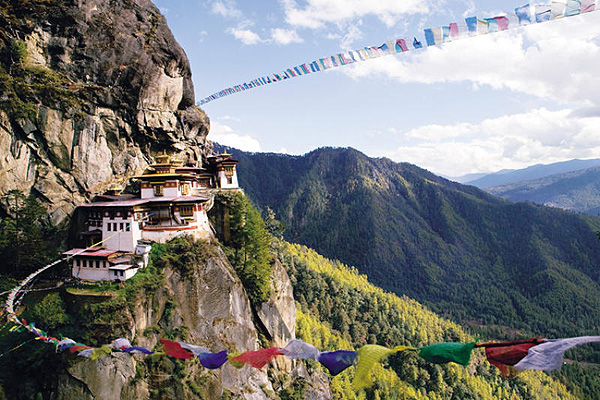
By Ajarn Helen Jandamit
Photos courtesy of Bangkok Post
University Tips is here to help you prepare for the English exams and tests that are coming your way. It gives you practise answering questions similar to those you may have at school and also on the University Entrance Examination.
Read the following article by Patipat Janthong from the Bangkok Post. Then, answer the questions that follow.
Bhutan, high in the Himalayas, has come to represent isolation. It is not only a country of rocky mountains where monks retreat to meditate; it is also a small, landlocked kingdom of fewer than 800,000 people squeezed between the world’s two most populous nations. Over the centuries, Bhutan disengaged from the rest of the world, banning television and the Internet until 1999 and calling its economic policy the pursuit of gross national happiness.
The number of visitors is rising. About 100,000 tourists are expected this year, compared to only 10,000 two decades ago. As the plane drifts between the mountains bound for the landing strip of Paro Airport, I wonder what sort of greeting the Land of the Thunder Dragon will provide.
The scenery was spectacular. The air was thinner and fresher. The languid fluttering of the prayer flags by a river suggested that time was moving more slowly.
In the quiet of the next morning in Paro, I left my accommodation and climbed along a ridge. I came across a small cottage on the hill where an elderly Bhutanese lady gave me a kind smile.
“Hello traveller,” she said. It was a warm welcome, and she let me photograph the cottage that is her home. Inside, her grandson was having breakfast and preparing himself for school. Her granddaughter was still drowsy from waking up in a bedroom decorated with Buddhist calendars and posters. With the grandmother’s permission, I followed the boy as he carried his Spider-Man backpack while walking to school with a friend.
The next morning, the destination was 10 kilometres to the north and nearly 1 kilometre above Paro. Taktsang (Tiger’s Nest) Monastery stands 3,120 metres above sea level and you can only get there on foot or horseback.
When we arrived at the monastery it was amazing to think that it was built in 1692. It is built around a cave which, according to legend, was where Guru Rinpoche meditated for three months in the 8th century after riding a tiger from Tibet.
After coming from Bangkok, nowhere in Bhutan seems hurried or noisy. This is true even in the capital, Thimphu. It is a 51 kilometre trip from Paro to Thimphu, and we reach the city of about 80,000 people in the dark. Light streams from the windows of the traditional square-shaped Bhutanese-style buildings. There are shops and stalls, more cars on the road and greater development.
In the morning, taking a stroll in the refreshing 15 degrees Celsius temperature, I saw students waiting for the school bus. When I lifted my camera to take their photos, smiles appeared and they laughed.
While waiting for a bus to make the 77 kilometre trip from Thimphu to Punakha, I enjoyed tea and snacks from street stalls. The trip to Punakha, a small town, took more than four hours. Punakha Dzong, the town fortress, was our first stop.
Wandering around the town in the evening, I saw an impressive sight. Down the hill stood Khuruthang Gompa, and the “Buddha Eyes” at the top of the pagoda could be clearly seen even from far away. Upon entering the pagoda, many locals were walking around and spinning prayer wheels. I sensed that it is religion that binds the Bhutanese people to their traditional and peaceful way of life.
Exercises
Section 1
Read the story. Then, answer the multiple-choice questions.
1. Bhutan is known as the __________________________ .
a. Land of Smiles
b. Land of Happiness
c. Land of the Thunder Dragon
2. According to the story, how many tourists are expected to visit Bhutan this year?
a. Around one million visitors.
b. Around 100,000 visitors.
c. Around 10,000 visitors.
3. Which of the following did the author not mention in the story?
a. The population of Bhutan.
b. Bhutan’s economic policy.
c. Gross domestic profit.
4. When did Bhutan access television and the Internet?
a. In 1969.
b. In 1999.
c. In 2009.
5. How many people live in Thimphu?
a. About 80,000.
b. About 800,000.
c. About eight million.
6. Where did the author witness the Buddha Eyes?
a. Khuruthang Gompa.
b. At Punakha Dzong, the Punakha town fortress.
c. In a cave.
7. What does the word Taktsang mean?
a. Peaceful town.
b. Tiger’s nest.
c. Landlocked kingdom.
8. How far is it from Thimphu to Punakha?
a. 7 kilometres.
b. 77 kilometres.
c. 777 kilometres.

Section 2
Read the story and decide whether each of the following statements is true or false.
9. The author said that the temperature in Thimphu was 15 degrees Celsius.
……………………
10. Thimphu is the name of road in Paro.
……………………
11. According to the author, Bhutan is a busy, noisy country.
……………………
12. Bhutan is a landlocked country.
……………………
Section 3
Fill in the blanks in the following passage with the correct words from the choices given.
I followed them halfway to school, about 1 kilometre …..13….. the ridge. Even in that short distance, we could …..14….. a number of orchards and dairy farms in Thimphu. The children were enjoying …..15….. time. It reminded me .....15….. journeys to school …..16….. my best friend in Punakha, my home town.
13.
a. under
b. along
c. in
14.
a. saw
b. see
c. seen
15.
a. them
b. there
c. their
16.
a. on
b. off
c. of
17.
a. how
b. whether
c. with

Section 4
Read each of the following sentences and underline the grammatically correct words in each from the choices given.
18. It took long/longer/longest than four hours to get to the small town Punakha.
19. We stopped at the town fortress call/called/calling Punakha Dzong.
20. The only ways to got/get/getting there are on foot or on horseback.
21. The city is situated on/under/at the end of the Himalayas.
Section 5
Find words in the story that can be used to correctly fill in the blanks in the following sentences.
22. The teacher gave her _______________ to leave class early.
23. In the current ______________ conditions, we must keep costs down.
24. The bus was already crowded, but somehow more people ________ on board.
Vocabulary
- isolation (n): the act of separating something
landlocked (adj): almost or completely surrounded by land
disengage (v): to separate yourself from something
monastery (n): a building in which monks live together


